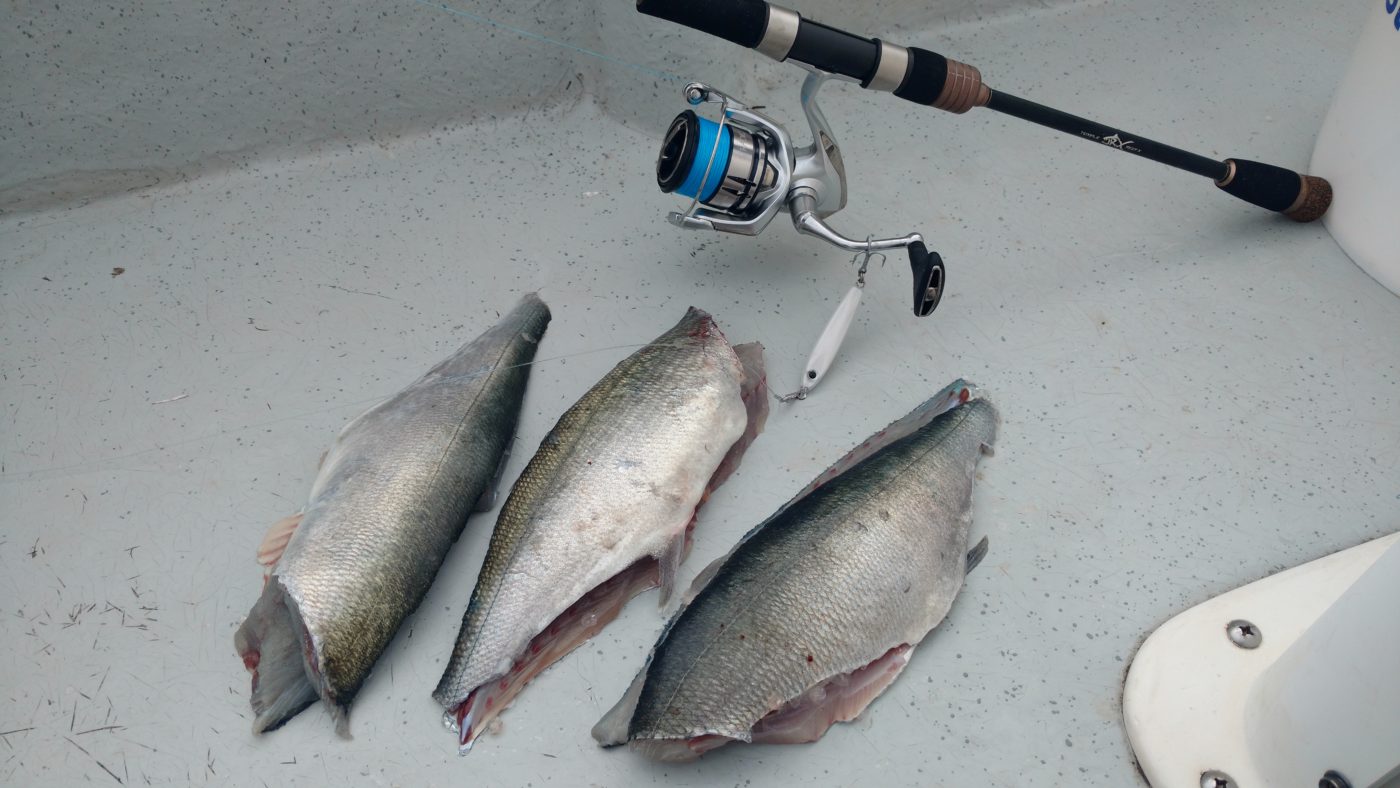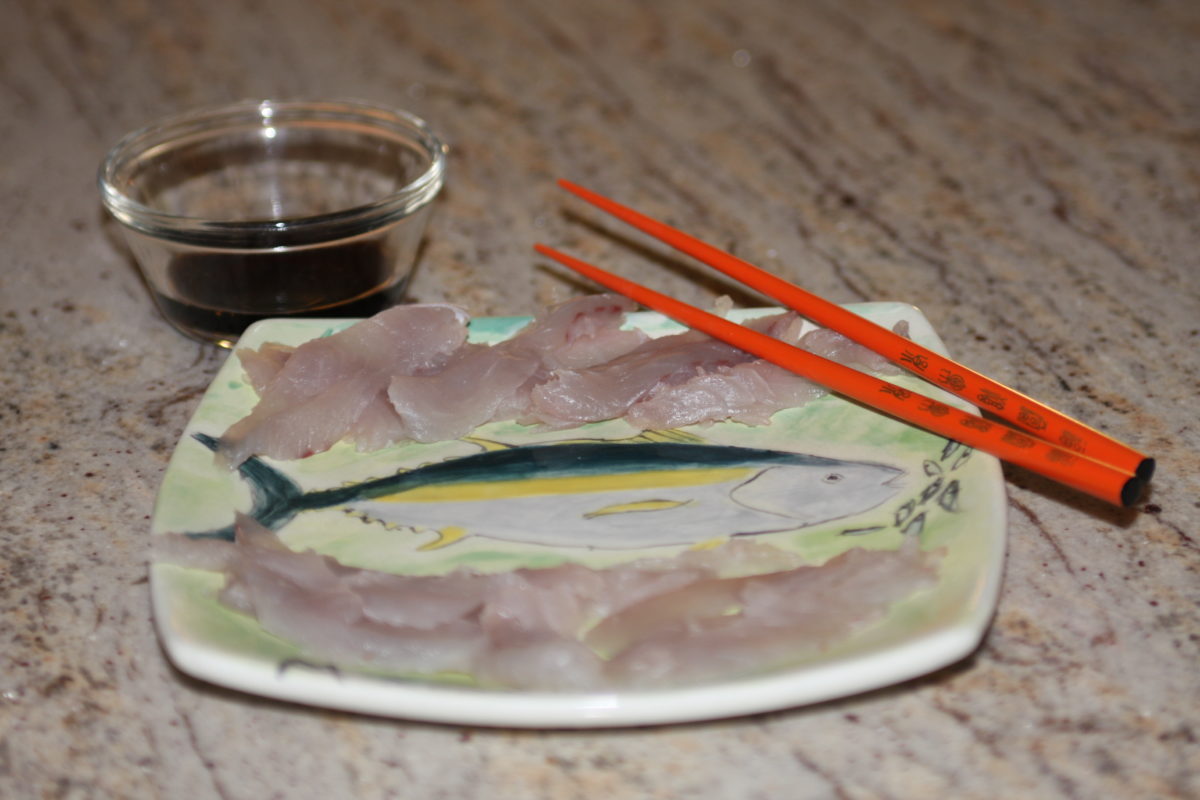It's Bluefish Sashimi Time
Posted by GAME ON on 6th Jul 2020
Story and Photos by Capt. Tom Migdalski
As we closed the running distance to less than a mile, I was able to discern a cloud of birds working along a shallow reef off the shoreline. I called over the center console to my fishing partner Dave Bard, gave him an enthusiastic, “We found them!” thumbs-up and throttled a few more horses to the RPMs.
We soon arrived at the action, and I cut the motor just up-tide of the rip line and breaking fish. Pods of rain-bait exploded through the surface while small bluefish slashed at them from beneath, some catapulting themselves a foot or more into the air. Terns and gulls wheeled, screamed, and dove as they picked off the hapless baitfish. We didn’t waste time feeling sorry for the scattering prey as we snatched our rods from the rocket launchers and started casting. Moments later, we were both hooting as our spools spun in harmony.
Dave and I had been stalking the reefs off Branford, Connecticut, seeking schools of small bluefish that have been marauding through Long Island Sound in recent summers. Although large “slammer” blues remain comparatively scarce in our nearshore areas, these one- to two-year-old fish, commonly called “harbor blues” and “tailor blues” have been plentiful, as have those in the next year-class up.
A great tackle combo for ultimate sport and strength is a Temple Reef (templereef.com) Vortex V1 light-action spinning rod attached to a quality 3000-series reel like Shimano’s Stradic loaded with 12- to 15-pound braid. This type of outfit handles any size bluefish and is a perfect match for making long heaves to breaking fish with any of the Game On EXO Casting Jigs.

We carefully played and released dozens of fish that day, but kept a few for a special treat that evening. For seafood lovers, few things are better than fresh bluefish sushi, or in this case, sashimi. Here’s how those terms differ:
Americans erroneously refer to any combination of raw or smoked fish served at a sushi bar—with or without the various ingredients of seaweed, rice and other trimmings—as “sushi.” Technically, sushi refers to only the sweet, vinegar-treated sticky rice. We’re a bit more precise when we say “sushi” if ordering the small, hand-pressed bricks of rice with thin slices of raw fish laid over it. That combination, however, is actually “nigiri sushi.”
Sushi rolls—basically a paper-thin sheet of dry nori (seaweed) covered with a layer of sticky rice, with fish and other accompaniments (like cucumber or avocado) in it—are very popular with American diners. A roll in its finished form is log-shaped; it’s then sliced into about six bite-size pieces with a super-sharp, wet knife. Rolls are accurately called “maki sushi,” and rolls with rice on the outside (rather than nori on the outside) are “yukiwa-maki.” If you are eating just plain, raw fish without the rice—as we were intending with the bluefish—it’s then called “sashimi.”
Making your own sushi rolls isn’t too complicated but takes some practice—a quick trip to any grocery store should provide you with dried seaweed sheets, soy sauce and wasabi. The sticky rice, important as opposed to regular rice, is a bit time consuming to get right, so I just stop at a local Japanese restaurant on the way home and buy a quart of their already-cooked sticky rice. If you do get into making your own raw fish dishes, you’ll eventually want to invest in a high-quality, super-sharp knife or two.
“Some of the best knives on the market are made by Shun,” says cooking expert and instructor Dan Price, owner of Kitch (kitchmystic.com), a unique, quality cookware, utensils, and gadget store in Olde Mistick Village in southeastern Connecticut. “The Shun knives lineup, which we carry, is extraordinary for its precision craftsmanship and razor-sharp edges—they’re truly a work of art. It makes food prep of delicate items like sushi and sashimi a pleasure rather than a struggle.”
The first step in preparing any high-quality sashimi or sushi product, however, isn’t slicing up a fillet in your kitchen with a fancy Japanese knife. It begins when you land your catch. If you have the luxury of a variety of fish sizes to choose from—as often happens when bluefishing—smaller is better. Younger fish are more tender, less fatty, and carry lower levels of toxins like PCBs and mercury (cooking will not reduce those elements). Once you catch the fish you wish to keep, bleed it immediately.
There are several acceptable ways to bleed a fish. The best for our purpose is to hold it in the water (being wary of the sharp teeth), slit its throat and abdomen and remove its entrails. Let the blood drain, and rinse it in the saltwater. Bleeding the fish while it’s alive thoroughly flushes the blood from its body, which also provides blood-free fillets.
Immediately ice the whole fish. Contrary to common belief, ice’s cooling property only chills food by direct contact, not by chilling the surrounding air in the fish chest, so distribute the ice cubes on both sides of the fish as well as packing it into the abdominal cavity. This method not only ensures your fish is cold and safe to eat raw, but it also makes the flesh firm for higher quality sashimi.
When you’re ready to fillet your bluefish (or any other suitable saltwater fish like striped bass, bonito, sea bass or fluke), have all your work surfaces clean. If you’re at home, this is obviously easy to do. However, if you’re filleting on a communal table at a marina, for example, carry a small and inexpensive bottle of 50/50 bleach and water solution (or just buy a spray bottle of Lysol or Clorox multi-surface cleaner & bleach) to treat the cutting board, table and knife blade to prevent contamination.

Let the bleach solution sit on the surfaces for a minute or two, then rinse with clean water. Fillet and skin your catch with care, and immediately place the fillets in sealed, food-grade plastic bags and bury them in ice for the trip home. A good practice, whether filleting on a cutting board or just on a clean boat deck, is to be mindful to always have fillets handled and packed flesh-to-flesh with skin side out (or down). This eliminates chances of cross contamination. Never rinse your fillets. When cared for properly, such as previously described, there’s no need to wash fillets—the water makes the flesh soggy and soft. (By the way, also never eat raw freshwater fish because of a great risk of parasites.)
At home, place the fillets on a clean cutting board. Pat dry with paper towels. If you haven’t already, skin them, and then trim off all dark meat and any bones. Make the thinnest, diagonal slices possible—again, a high-quality knife is very helpful here—and cut those into bite-size pieces and arrange on a chilled plate. Serve small crackers as an accompaniment (Red Oval Farms “Mini Stoned Wheat Thins” are a good match), if desired. Provide chopsticks and/or seafood forks for guests to dip the slices in a soy sauce/wasabi mix. Or just use your fingers. Eat fish alone or place on crackers. Sashimi is tasty, healthy, and a lot easier than making sushi. Enjoy.

